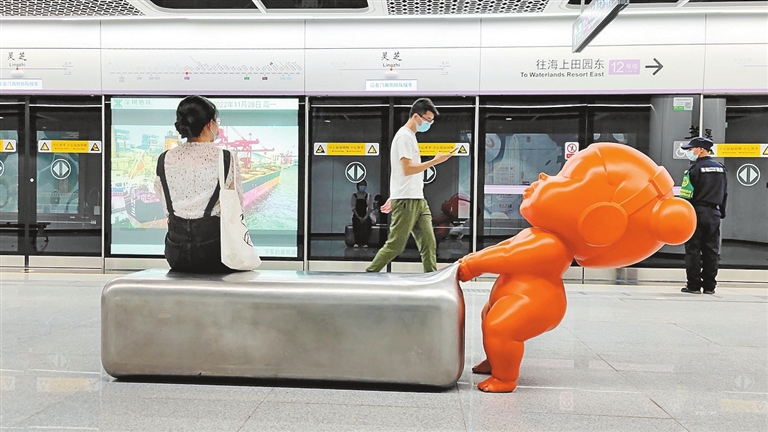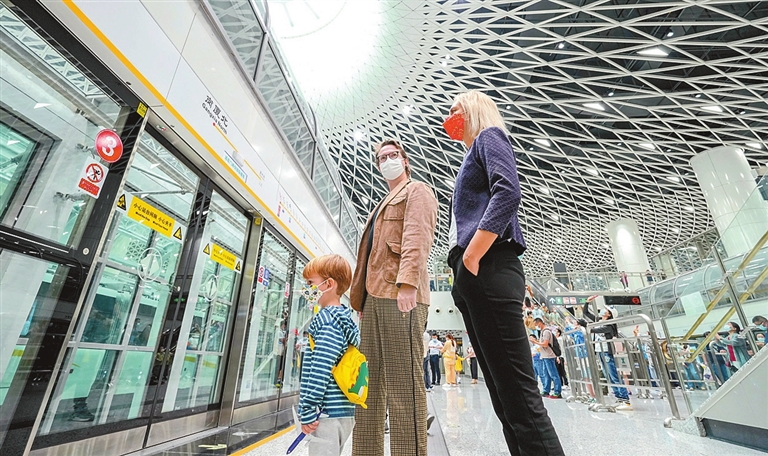

Simon Chiatante From Italy IT’S a chilly mid-week morning, 8:30 a.m. Dressed in a suit and tie, carrying my leather handbag, and in a pair of leather shoes, I was focused on the current projects, ready to face the full rush hour, at least here, between the Longgang and Luohu areas, on Metro Line 3 heading towards the Futian area. Can rush hour be relative? Of course, it is. In Shenzhen, there are different rush hours according to people’s various business lines and ages: Whether they are retired, rushing to first classes in school or kindergarten. There are also huge gaps between the different directions of the Metro train and especially the stops. Every stop and each transfer, where Metro lines intersect at stations, people’s lives crisscross through. Here, in the middle of Line 3, depending on where you are headed and where you work, you may have to wake up earlier. Let’s say, get on the Metro an hour in advance of your usual time to avoid the crowds, unless you are one of those who like to observe, learn, and be inspired by what surrounds you. Residential areas such as this one offer a wider spectrum of personalities, goals, and feelings, but this too, is a generalization. Let’s say a worker gets on the subway at 7 a.m. Repair work is needed on the other end of the city. You may never know at which point you will meet him, which station he gets on, and where he’ll transfer. He is there, cheerfully watching a period drama on his phone, easing the weariness that’s yet to come. The speakers are slightly loud as he leans in a corner of the last car, on Line 6 directed to Guangming, far in the northwest of Shenzhen. Right there, at 9:30 a.m., an old man with a red bag of tangerines in his hand is waiting for the Metro at Gongming Square Station. This area is a particularly lively one, which almost looks like another city in Guangdong, one of those growing big cities in the southwest of the province, where traditions are vibrant. While he waits for the train, he keeps staring at the station’s name written in calligraphy style. He may be a calligraphy teacher, or simply someone whose aesthetic sensibility for such art has always been acute, as is the case with many from his generation. The Metro station is quite modern, but its name on the wall of the station is outlined in a traditional calligraphy script, as in most Metro stations in the city. Each Metro station name is rendered in a specific script. This definitely adds depth to their identity, and one can’t help but wonder who was commissioned to come up with the station names. Chinese calligraphy requires execution with a clear mind, with the heart and brush flowing as one. In one stroke after another, each Metro line and its stations have their unique identity and style, as they all connect different worlds. Lines 3 and 7 are represented by the so-called “running script,” a freer version of the “standard script,” allowing for a fuller expression of feelings. It’s still simple and legible, elegant; while lines 1 and 4 showcase the same script but with thicker strokes, a more serious and rugged look, almost speaking out for the older establishment of these central city lines. Some of the newer lines, such as lines 10 and 14, are surprisingly represented by the more ancient and spiritual “clerical script,” a style that expresses depth but also intense simplicity, maybe conveying a return to a more essential reality. These are the lines that connect the city center to the universities and to the outer residential areas with faster trains, for people who are more on-the-go or busier. Along these lines, where new housing projects are constantly being built, you almost see the tangible “future.” In Metro stations and trains, everyone is rushing to the future and exploring the unknown. Always searching, but for what? We do not know yet, but that’s the Metro system we all ride, after all. | 
